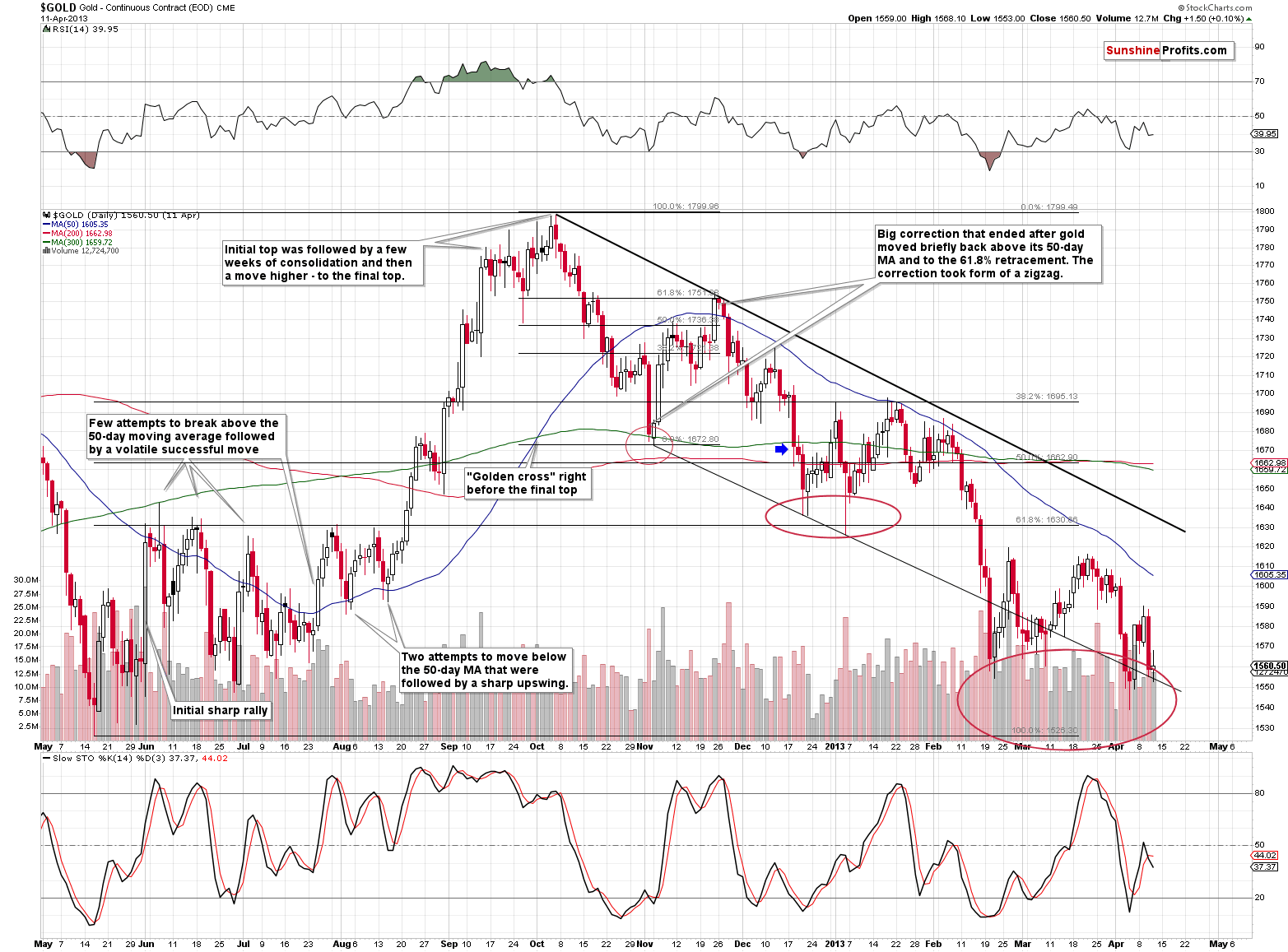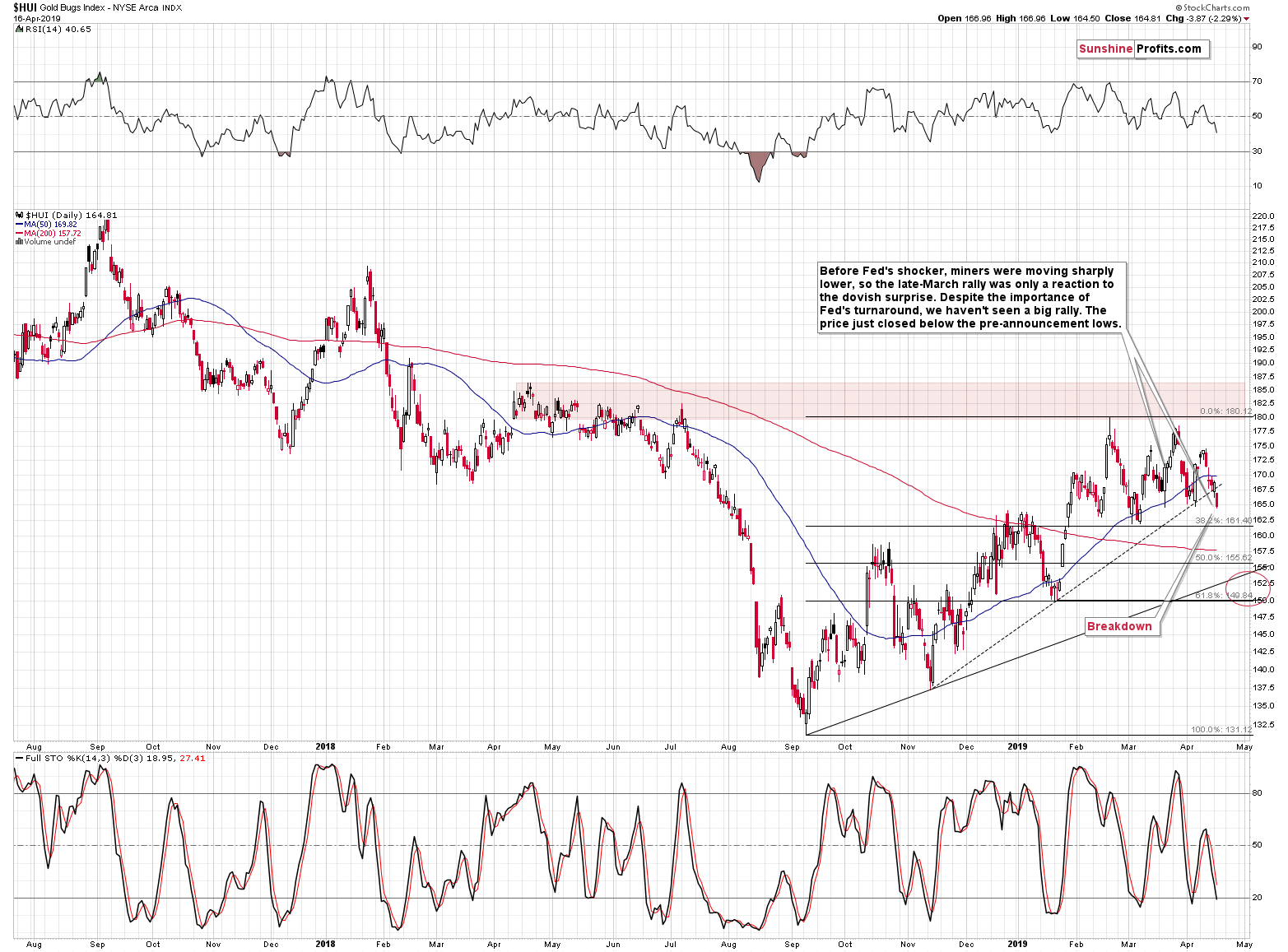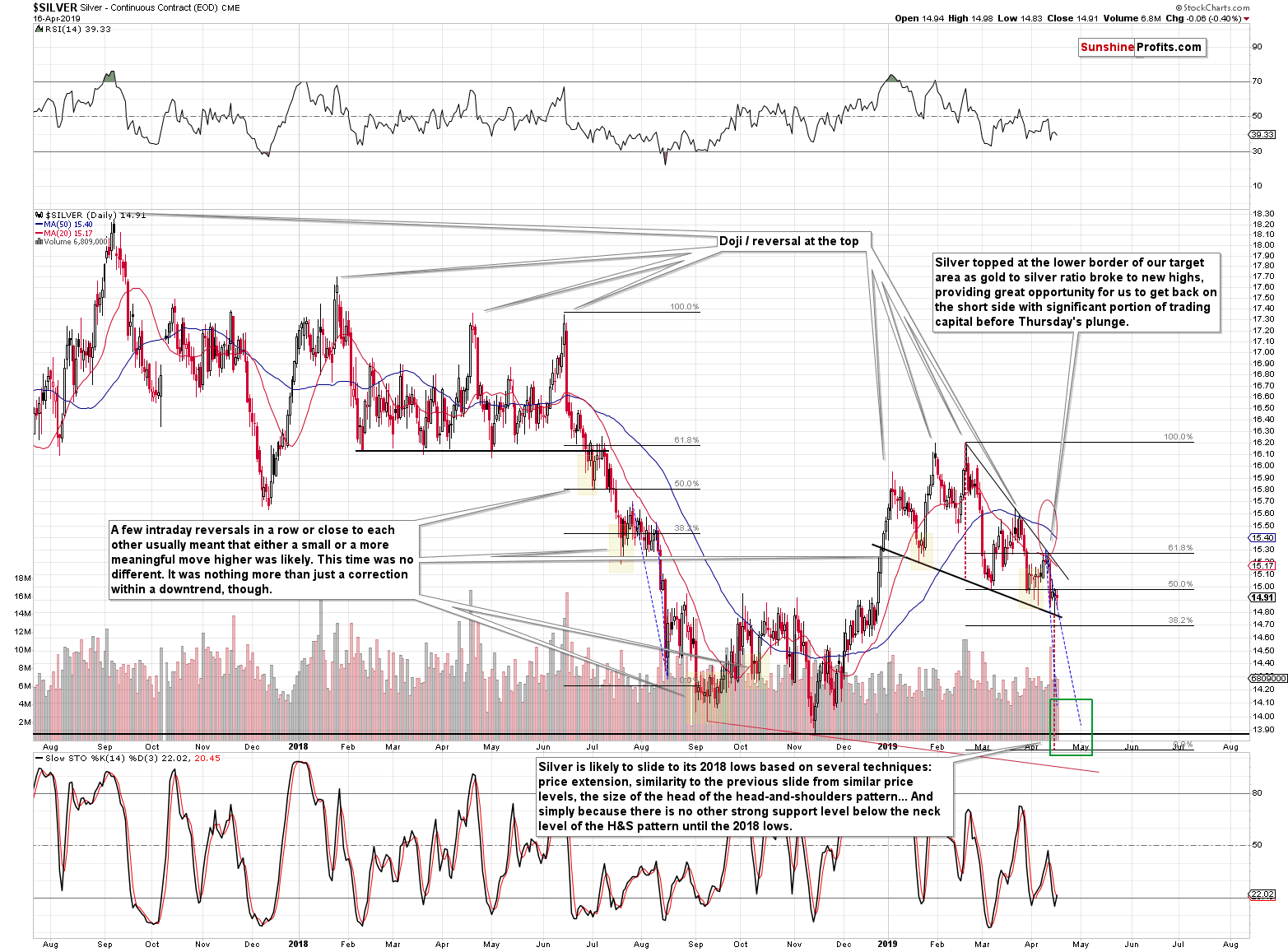Briefly: in our opinion, full (250% of the regular size of the position) speculative short position in gold, silver, and mining stocks is justified from the risk/reward perspective at the moment of publishing this Alert.
Last April, while discussing the boomerang question about the trigger that is needed for gold to decline, we emphasized that gold can decline on... absolutely nothing. It's imperative to keep watching the signs and determine when the market is really ready to move. There's a lot of calculations, trading techniques etc. behind all that, but it does all really come down to it. Now, there are many definitions of "nothing", but surprisingly none of them mentions "0.09 move in the USD Index". That's something that should to be updated and we're waiting for the Merriam-Webster editors' reply to our request. Seriously though, USD's meager rally was really next to nothing and both: gold and gold stocks declined and broke below their support lines nonetheless, just like we've been expecting them to. And that happened shortly after they both failed to rally substantially on the Fed's dovish shocker. Before gold declined a few days ago, we wrote that the easy part of the rally was over, and that it might be a good idea to close all the remaining long positions. The good news is that the easy part of the decline has just begun.
The Straw That Broke Gold's Back
The analogy that we discussed on Friday remains in place and so do its implications, so we'll start the description of the above chart with a quote:
The second analogy is to the mid-2018 decline. The decline accelerated once it broke below the nearest support line and the previous lows. In 2018, it happened in June. We are not yet at this stage, but we are very close. We marked the similar days with blue arrows.
Based on the above analogy, we can expect gold to slide until it reaches the previous important bottom. The nearest important bottom is at about $1,200 (formed in November 2018). There are also two smaller bottoms that might also trigger a temporary reversal: the late-November bottom at about $1,210 and the mid-December bottom at about $1,236. The latter is very close to the previously mentioned 61.8% Fibonacci retracement, which gives it more credibility than the remaining levels.
There's also the head-and-shoulders formation that will come into play once gold breaks below the neck level. It's relatively close - at about $1,285, so gold would need to decline by only $8 from yesterday's close to reach it. The target based on this formation is created by applying the size of the "head" to the moment and price of the breakdown. This technique points to $1,220 as the likely target for gold.
Of course, there's also the rising support line that's based on the August and November 2018 lows and it points to $1,250 as the likely near-term target.
This week, we supplemented the above with a note that the daily June 2018 decline was followed by a small pause, so the recent pause was nothing bullish (even though we saw a bullish reversal on Monday). Based on yesterday's slide and the breakdown below the neck level of the above-mentioned head-and-shoulders formation in gold, it's clear that the analogy remains intact. Back in 2018, that was the moment when the decline started to accelerate, so this seems quite likely also this time.
Naturally, the breakdown below the head-and-shoulders pattern is not yet confirmed, but given what kind of (in) action triggered it, it's very likely that it will be confirmed shortly.
The above quote starts by stating that the above is a "second analogy", so you'd likely be interested in the first analogy as well. And we deliver.
The first analogy is to the decline's shape in 2012 and 2013.
Lessons from 2012 and 2013
There are multiple reasons as to why the current situation is similar to the one in 2012 and 2013 and some of them are present on the above chart. Other confirmations come from other markets. But we don't want to get into details here as that's not the point to make. What we want to emphasize is that the similarity exists also on a short-term basis and it's quite remarkable.
It was this analogy that helped us detect the top in gold in late March and it was also the thing that contributed to us predicting gold's corrective upswing earlier this month. In other words, it's very useful.
In line with the previous chart, we added a blue arrow on the 2012 chart as a "you are here" note. At first sight, the implication might be that the decline is coming to an end because back in 2012, when gold moved below its recent lows, it kept on declining for just a few more days and formed the initial bottom relatively close. This may not be the correct impression, though.
The analogies can work in terms of price or time, or both. They can also work in absolute terms and in relative terms. Starting with the former, we see that the analogy works only approximately well in terms of time and we see that the next short-term bottom was rather broad. Yes, the initial bottom formed shortly, but then gold moved back and forth for about 2 weeks and the final near-term bottom formed in early January 2013. Consequently, gold may have more time to decline this time than it seems at the first sight.
As far as price levels are concerned, we see that they are quite precise, but this is the case in relative terms, not in absolute ones. And in relative terms, in late 2012 and early 2013, gold kept on declining until it moved close to the 61.8% Fibonacci retracement level based on the preceding rally. This level also corresponded to the previous local highs. The analogous price level that we have this time is at about $1,240. What is truly remarkable is that this time the 61.8% Fibonacci retracement also corresponds to the previous local highs. This striking similarity adds to the analogy's credibility.
Combining both provides us with a scenario in which gold doesn't bottom almost right away, but instead declines in a more meaningful manner.
Consequently, even if gold moves back and forth here (possibly creating day trading opportunities; by the way, out of the 10 verifiable in real-time Signals, 9 were profitable), it will unlikely mark the end of the decline. And that's only based on factors that we see in gold alone. Let's take a look at one of gold's key drivers.
Happy USDX Bottom Anniversary!
As we wrote earlier today, the USD Index has barely done anything, and the strength of gold's reaction confirmed where it really wants to move - lower.
But there is one additional thing that is important here as well. It's the fact that the USDX seems to have bottomed or is extremely close to bottoming. The index closed the day a bit higher, and it was the second day in a row where there was no new intraday low. This is a bullish indication, and given the proximity of the rising medium-term support line, the bottom is likely already in.
Bottoms are likely to form once the price reaches the support and this may very well be the case also here. If it were an ordinary situation, the USDX would be likely to first decline to 95.75 before rallying. However, the current situation is not ordinary. It's similar to the January - April 2008 bottom that looked like an incomplete head-and-shoulders pattern. Back then, the USDX bottomed above its support lines, so something similar might have already happened right now as well.
The bottom that started the most powerful rally of the recent years formed exactly one year ago. If the 1:1 seasonality continues (after all, the USD topped in November and December and formed the first bottom in January in both cases), we're going to see a massive increase in the value of the USD Index. And yes, the USDX's reaction to the fundamental picture confirms it. Fed's dovish shocker was unable to trigger a sustainable decline, which proved a great strength of the US currency.
Needless to say, with rallying US dollar, gold is very likely to dive.
The Miners and Silver Cross-Examination
The miners declined and closed the day visibly below the rising dashed support line. That's the lowest close of the month and the lowest one since the Fed's dovish surprise. The market had more than enough time to absorb all the bullish implications that it might have rallied instead... Though, it declined anyway. This is a very bearish situation. The bearish surprises will keep emerging as well and we see that this is what the market wants to react to. When the USD Index truly rallies, then metals and miners are likely to dive.
The next support is provided by the previous lows and the rising support line. Once the HUI Index moves to the 150 - 152.5 area, we might see a corrective upswing, but it's not likely to be the end of the decline. It's not likely to be even close to the end of the decline. The next stop will likely be the September 2018 bottom, but... That's still not likely to be the end of the decline. And it likely will not be close to it either.
What about the part of the precious metals market that didn't break lower yesterday - silver?
The white metal declined in terms of the daily closing prices, but overall, we saw little action in it. Definitely not something like what we saw in gold and mining stocks. Why? There's no easy answer, and in fact, there may be none at all. The "experts" that you see on television are required to tell people why all the moves have happened, because that's what their employers require them to do regardless of whether they know that or not (at least that's what our friend that was featured in TV business news told us). We work for you and thus we have your best interest in mind, and we tell you exactly what we see, even if it means telling you that we don't think that there is a clear explanation behind a given price move. And this is exactly what it looks like this time.
The daily moves can rarely be explained, which is why we are usually waiting for a confirmation before taking action. Yesterday's silver action might have been random. It might have also been the case that silver traders were reluctant to follow gold's lead until the breakdown below the previous lows is confirmed. Or it could be the case that silver is showing the temporary strength as a sign of the upcoming slide. Silver usually does that while rallying. Ultimately, temporary strength during a daily decline might also be viewed as something similar.
Still, it's not that important why a given move took place. What matters, is whether something actually has changed.
While it's not clear as to why silver didn't slide yet, it's possible to come to the conclusion that it didn't really change anything. The white metal's decline is still perfectly similar to the pace of decline from August 2018 as indicated by the dashed, blue lines. Consequently, the outlook for the white metal remains bearish and silver's pause shouldn't be viewed as a bullish divergence. Let's keep in mind that when silver moves, it really moves, so a day or two of delay is nothing out of the ordinary.
Summary
Summing up, the USD Index appears to be bottoming, while gold and mining stocks have already broken below their key support levels. These signs confirm that the big move lower is already underway. Silver hasn't declined yet, but it doesn't seem to change anything as its overall decline is in tune with its last year's decline. Based on the likelihood of seeing a temporary turnaround in the next 1-3 weeks, we might have a good chance of exiting the current short position or even switching to a long one at that time.
As always, we'll keep you - our subscribers - informed.
To summarize:
Trading capital (supplementary part of the portfolio; our opinion): Full short position (250% of the full position) in gold, silver, and mining stocks is justified from the risk/reward perspective with the following stop-loss orders and exit profit-take price levels:
- Gold: profit-take exit price: $1,252; stop-loss: $1,357; initial target price for the DGLD ETN: $50.97; stop-loss for the DGLD ETN $39.87
- Silver: profit-take exit price: $14.11; stop-loss: $15.72; initial target price for the DSLV ETN: $36.97; stop-loss for the DSLV ETN $26.97
- Mining stocks (price levels for the GDX ETF): profit-take exit price: $20.41; stop-loss: $24.17; initial target price for the DUST ETF: $24.28; stop-loss for the DUST ETF $15.47
In case one wants to bet on junior mining stocks' prices (we do not suggest doing so - we think senior mining stocks are more predictable in the case of short-term trades - if one wants to do it anyway, we provide the details), here are the stop-loss details and target prices:
- GDXJ ETF: profit-take exit price: $29.62; stop-loss: $35.67
- JDST ETF: profit-take exit price: $52.32 stop-loss: $30.97
Long-term capital (core part of the portfolio; our opinion): No positions (in other words: cash)
Insurance capital (core part of the portfolio; our opinion): Full position
Whether you already subscribed or not, we encourage you to find out how to make the most of our alerts and read our replies to the most common alert-and-gold-trading-related-questions.
Please note that the in the trading section we describe the situation for the day that the alert is posted. In other words, it we are writing about a speculative position, it means that it is up-to-date on the day it was posted. We are also featuring the initial target prices, so that you can decide whether keeping a position on a given day is something that is in tune with your approach (some moves are too small for medium-term traders and some might appear too big for day-traders).
Plus, you might want to read why our stop-loss orders are usually relatively far from the current price.
Please note that a full position doesn't mean using all of the capital for a given trade. You will find details on our thoughts on gold portfolio structuring in the Key Insights section on our website.
As a reminder - "initial target price" means exactly that - an "initial" one, it's not a price level at which we suggest closing positions. If this becomes the case (like it did in the previous trade) we will refer to these levels as levels of exit orders (exactly as we've done previously). Stop-loss levels, however, are naturally not "initial", but something that, in our opinion, might be entered as an order.
Since it is impossible to synchronize target prices and stop-loss levels for all the ETFs and ETNs with the main markets that we provide these levels for (gold, silver and mining stocks - the GDX ETF), the stop-loss levels and target prices for other ETNs and ETF (among other: UGLD, DGLD, USLV, DSLV, NUGT, DUST, JNUG, JDST) are provided as supplementary, and not as "final". This means that if a stop-loss or a target level is reached for any of the "additional instruments" (DGLD for instance), but not for the "main instrument" (gold in this case), we will view positions in both gold and DGLD as still open and the stop-loss for DGLD would have to be moved lower. On the other hand, if gold moves to a stop-loss level but DGLD doesn't, then we will view both positions (in gold and DGLD) as closed. In other words, since it's not possible to be 100% certain that each related instrument moves to a given level when the underlying instrument does, we can't provide levels that would be binding. The levels that we do provide are our best estimate of the levels that will correspond to the levels in the underlying assets, but it will be the underlying assets that one will need to focus on regarding the signs pointing to closing a given position or keeping it open. We might adjust the levels in the "additional instruments" without adjusting the levels in the "main instruments", which will simply mean that we have improved our estimation of these levels, not that we changed our outlook on the markets. We are already working on a tool that would update these levels on a daily basis for the most popular ETFs, ETNs and individual mining stocks.
Our preferred ways to invest in and to trade gold along with the reasoning can be found in the how to buy gold section. Additionally, our preferred ETFs and ETNs can be found in our Gold & Silver ETF Ranking.
As a reminder, Gold & Silver Trading Alerts are posted before or on each trading day (we usually post them before the opening bell, but we don't promise doing that each day). If there's anything urgent, we will send you an additional small alert before posting the main one.
Thank you.
Sincerely,
Przemyslaw Radomski, CFA
Editor-in-chief, Gold & Silver Fund Manager










